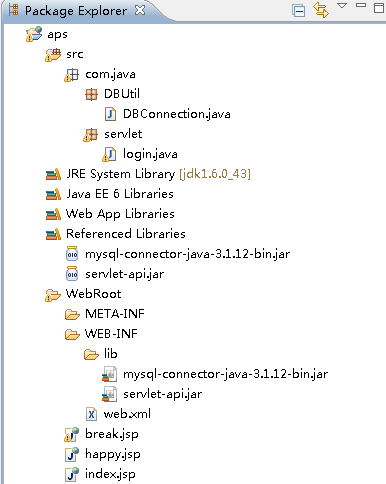支持原创,支持arrAy_1
关于servlet。我想大多数java初学者或多或少都有点困惑。arrAy也不例外,记得第一次面试的时候,面试官让在笔记本上编写一个servlet实现密码验证功能。后面。。。你们懂得。
废话不多说,这篇文章,主要是通过编写一个简单的servlet来让大家能对servlet能有更好的掌握。
第一步:新建web project 大致的包结构如下:

需要连接数据库查询。这里采用了mysql3.1.12版本jar包。在导入servlet必备servlet-api.jar。src下,建立DBUtil和servlet两个文件夹。ok,项目结构大概就是这样。
第二步:在servlet下新建一个名为login的class,继承HttpServlet类。重写它的doGet和doPost方法。
package com.java.servlet;
import java.io.IOException;
import java.io.PrintWriter;
import java.sql.SQLException;
import javax.servlet.http.HttpServlet;
import javax.servlet.http.HttpServletRequest;
import javax.servlet.http.HttpServletResponse;
public class login extends HttpServlet {
public void doPost(HttpServletRequest req,HttpServletResponse rson){
}
public void doGet(HttpServletRequest req,HttpServletResponse rson){
//通过调用doPost方法可将用户的get请求用post方法处理(如果需要)。
doPost(req, rson);
}
} 第三步:这个时候,我们就可以进行配置我们的web.xml文件了。在web.xml里面写一个servlet和一个servlet-mapping.把刚才写的login路径放进去,并将两个servlet-name对应一样。
<?xml version="1.0" encoding="UTF-8"?>
<web-app version="3.0"
xmlns="http://java.sun.com/xml/ns/javaee"
xmlns:xsi="http://www.w3.org/2001/XMLSchema-instance"
xsi:schemaLocation="http://java.sun.com/xml/ns/javaee
http://java.sun.com/xml/ns/javaee/web-app_3_0.xsd">
<display-name></display-name>
<welcome-file-list>
<welcome-file>index.jsp</welcome-file>
</welcome-file-list>
<servlet>
<servlet-name>login</servlet-name>
<servlet-class>com.java.servlet.login</servlet-class>
</servlet>
<servlet-mapping>
<servlet-name>login</servlet-name>
<url-pattern>/login</url-pattern>
</servlet-mapping>
</web-app>
ok,简单的servlet就已经搭建完成,现在我们开始连接数据库。在DBUtil里面新建类DBConnection,连接mysql需要url、用户名和密码三个参数。这里由于是测试例子,所有这三个参数我直接写成静态变量。
package com.java.DBUtil;
import java.sql.Connection;
import java.sql.DriverManager;
import java.sql.ResultSet;
import java.sql.SQLException;
import java.sql.Statement;
public class DBConnection {
static String username="root";
static String password="22222";
static String url="jdbc:mysql://192.168.0.9:3306/244-maxapp";
}这时我们需要通过java的反射机制去加载mysql驱动。class.forname通过传入的字符串到java虚拟机加载,抛出classnotfoundException。加载通过后我们通过DriverManager去获取mysql连接。
public static void InitDriver() throws ClassNotFoundException{
Class.forName("com.mysql.jdbc.Driver");
}
public static Connection getConnection() throws ClassNotFoundException, SQLException{
Connection c=null;
InitDriver();
c=DriverManager.getConnection(url, username, password);
return c;
}现在新建一个登录验证的方法,通过页面传入的用户名和密码,在将从数据库里面查询到的用户密码进行匹配。返回布尔值。
public static boolean logininfo(String username,String password) throws ClassNotFoundException, SQLException{
boolean b=false;
Statement s=null;
ResultSet r=null;
String sql="select vcuser,vcpassword from msdtb1701";
Connection c=getConnection();
s=c.createStatement();
r=s.executeQuery(sql);
while(r.next()){
if(r.getString(1).equals(username) && r.getString(2).equals(password)){
b=true;
break;
}
}
return b;
}ok,现在我们回到login类,开始编写doPost请求进行的操作。
package com.java.servlet;
import java.io.IOException;
import java.io.PrintWriter;
import java.sql.SQLException;
import javax.servlet.http.HttpServlet;
import javax.servlet.http.HttpServletRequest;
import javax.servlet.http.HttpServletResponse;
import com.java.DBUtil.DBConnection;
public class login extends HttpServlet {
public void doPost(HttpServletRequest req,HttpServletResponse rson){
String username=req.getParameter("username");
String password=req.getParameter("password");
try {
boolean b=DBConnection.logininfo(username,password);
if(b){
rson.sendRedirect("happy.jsp");
}else{
rson.sendRedirect("break.jsp");
}
} catch (ClassNotFoundException e) {
// TODO Auto-generated catch block
e.printStackTrace();
} catch (SQLException e) {
// TODO Auto-generated catch block
e.printStackTrace();
} catch (IOException e) {
// TODO Auto-generated catch block
e.printStackTrace();
}
}
public void doGet(HttpServletRequest req,HttpServletResponse rson){
doPost(req, rson);
}
}
关于jsp页面:
1、登录页面 index.jsp
<%@ page language="java" import="java.util.*" pageEncoding="utf-8"%>
<%
String path = request.getContextPath();
String basePath = request.getScheme()+"://"+request.getServerName()+":"+request.getServerPort()+path+"/";
%>
<!DOCTYPE HTML PUBLIC "-//W3C//DTD HTML 4.01 Transitional//EN">
<html>
<head>
<base href="<%=basePath%>">
<title>My JSP 'index.jsp' starting page</title>
<meta http-equiv="pragma" content="no-cache">
<meta http-equiv="cache-control" content="no-cache">
<meta http-equiv="expires" content="0">
<meta http-equiv="keywords" content="keyword1,keyword2,keyword3">
<meta http-equiv="description" content="This is my page">
<!--
<link rel="stylesheet" type="text/css" href="styles.css">
-->
</head>
<body>
<form action="logon" method="get">
用户名:<input name="username"/><br>
密码: <input name="password" /><br>
<input type="submit"/>
</form>
</body>
</html>
2、登录验证失败页面break.jsp
<%@ page language="java" import="java.util.*" pageEncoding="utf-8"%>
<%
String path = request.getContextPath();
String basePath = request.getScheme()+"://"+request.getServerName()+":"+request.getServerPort()+path+"/";
%>
<!DOCTYPE HTML PUBLIC "-//W3C//DTD HTML 4.01 Transitional//EN">
<html>
<head>
<base href="<%=basePath%>">
<title>My JSP 'index.jsp' starting page</title>
<meta http-equiv="pragma" content="no-cache">
<meta http-equiv="cache-control" content="no-cache">
<meta http-equiv="expires" content="0">
<meta http-equiv="keywords" content="keyword1,keyword2,keyword3">
<meta http-equiv="description" content="This is my page">
<!--
<link rel="stylesheet" type="text/css" href="styles.css">
-->
</head>
<body>
验证失败,请重新<a href="./index.jsp">登录</a>
</form>
</body>
</html>
以及最后一个登录成功之后返回的happy.jsp
<%@ page language="java" import="java.util.*" pageEncoding="utf-8"%>
<%
String path = request.getContextPath();
String basePath = request.getScheme()+"://"+request.getServerName()+":"+request.getServerPort()+path+"/";
%>
<!DOCTYPE HTML PUBLIC "-//W3C//DTD HTML 4.01 Transitional//EN">
<html>
<head>
<base href="<%=basePath%>">
<title>My JSP 'index.jsp' starting page</title>
<meta http-equiv="pragma" content="no-cache">
<meta http-equiv="cache-control" content="no-cache">
<meta http-equiv="expires" content="0">
<meta http-equiv="keywords" content="keyword1,keyword2,keyword3">
<meta http-equiv="description" content="This is my page">
<!--
<link rel="stylesheet" type="text/css" href="styles.css">
-->
</head>
<body>
恭喜你登录成功!
</form>
</body>
</html>
通过启动tomcat访问http://localhost:8080/aps可直接到达index.jsp。需要源码可邮箱我zhonglian520@gmail.com.






















 8629
8629

 被折叠的 条评论
为什么被折叠?
被折叠的 条评论
为什么被折叠?








